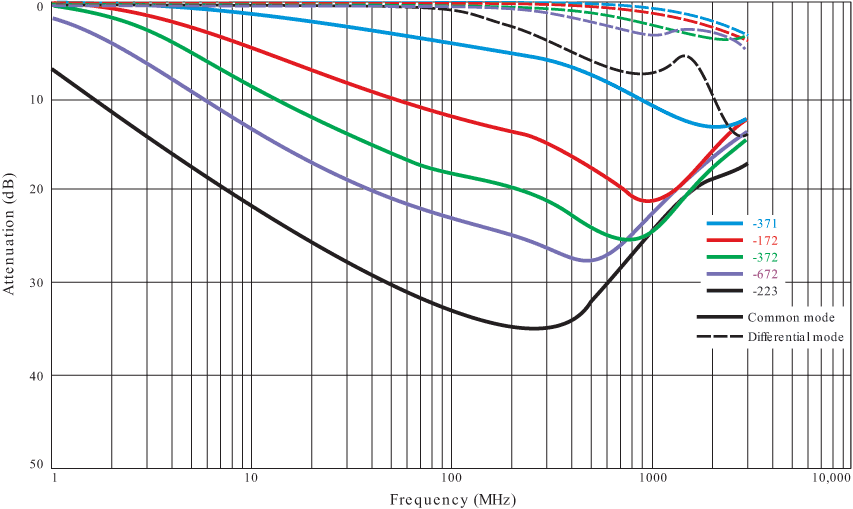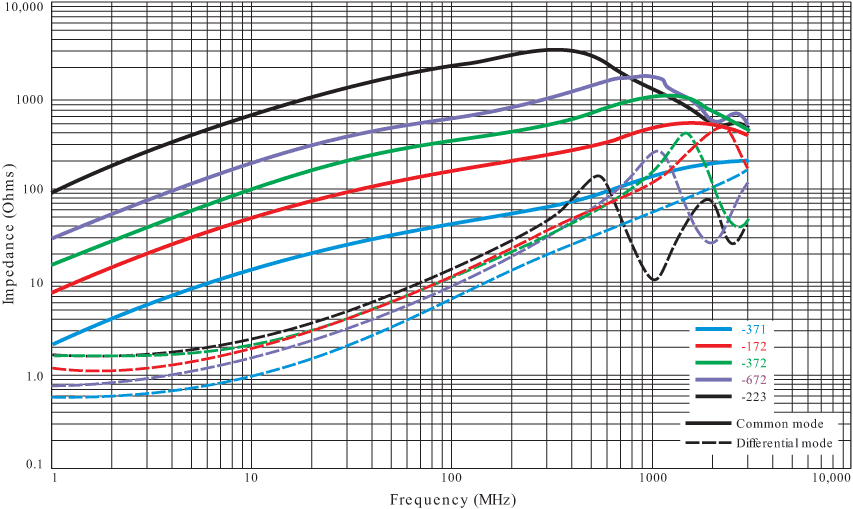
3D Model
Datasheet
AR376FRA Series
Common Mode Chokes for Critical Applications
AR376FRA Series designed for high-speed USB 3.0, HDMI, SATA, IEEE1394 and LVDS applications.
- For common mode noise suppression in high speed differential signal lines: USB2.0, IEEE1394, LVDS, etc.
- Up to 2.7 GHz differential mode 3 dB cutoff frequency
- Up to 2.24 kOhms common mode peak impedance and 40 dB common mode noise attenuation.
- Passes NASA low outgassing specifications
Specifications
| Part number 1 | Lines |
Common mode peak impedance (kΩ) |
Cutoff frequency (GHz) 2 |
Common mode attenuation typ (dB) |
Inductance min (nH) 3 |
Irms (mA) | DCR max (Ω) 4 |
Isolation Voltage (Vrms) 5 |
||
|---|---|---|---|---|---|---|---|---|---|---|
| 10 MHz | 100 MHz | 500 MHz | ||||||||
| AR376FRA371MPZ | 2 | 0.21 @ 3.0 GHz | 2.7 | 1.2 | 4.8 | 8.1 | 31 | 700 | 0.10 | 250 |
| AR376FRA102MPZ | 2 | 0.36 @ 1.9 GHz | 2.2 | 3.8 | 9 | 13.3 | 66 | 700 | 0.14 | 250 |
| AR376FRA172MPZ | 2 | 0.55 @ 1.5 GHz | 2.1 | 5 | 12.4 | 18 | 107 | 700 | 0.18 | 250 |
| AR376FRA262MPZ | 2 | 0.76 @ 1.1 GHz | 2.0 | 6.1 | 15.3 | 21 | 161 | 600 | 0.22 | 250 |
| AR376FRA372MPZ | 2 | 1.11 @ 1.1 GHz | 1.2 | 9.1 | 18.5 | 24.4 | 226 | 600 | 0.26 | 250 |
| AR376FRA532MPZ | 2 | 1.45 @ 0.93 GHz | 0.78 | 10.9 | 21.4 | 26.3 | 319 | 600 | 0.30 | 250 |
| AR376FRA672MPZ | 2 | 1.67 @ 0.81 GHz | 0.75 | 13.9 | 23.4 | 28 | 412 | 500 | 0.34 | 250 |
| AR376FRA872MPZ | 2 | 1.99 @ 0.72 GHz | 0.53 | 16.3 | 25.3 | 29.4 | 510 | 500 | 0.39 | 250 |
| AR376FRA113MPZ | 2 | 2.24 @ 0.66 GHz | 0.51 | 16.9 | 27.1 | 30 | 623 | 500 | 0.44 | 250 |
| AR376FRA223MPZ | 2 | 3.36 @ 0.34 GHz | 0.22 | 22.4 | 33.1 | 32.3 | 1040 | 300 | 0.85 | 250 |
Notes
- When ordering, please specify termination and testing codes: e.g. AR376FRA223MPZ.
- Frequency at which the differential mode attenuation equals −3 dB.
- Inductance measured at 100 MHz using an Agilent/HP 4286A impedance analyzer and a Coilcraft SMD-A fixture.
- DCR is specified per winding.
- Winding to winding isolation (hipot) tested for one minute.
Termination:
- P = Tin-lead (63/37) over tin over nickel over silver-palladium-glass frit.
- C = Tin-lead (63/37) over gold over nickel over silver-palladium-glass frit
- A = Gold over nickel over silver-palladium-glass frit
- R = Tin over nickel over silver-palladium-glass frit. Not suitable for applications or screening with pure tin restrictions.
Testing:
- Z = Unscreened
- H = Coilcraft CP-SA-10001 Group A
- G = Coilcraft CP-SA-10001 Group A (SLDC Option A)
- D = Coilcraft CP-SA-10001 Group A (SLDC Option B)
- F = ESCC3201 (F4 operational life performed at 90°C)
- 1 = EEE-INST-002 (Family 1) Level 1
- 2 = EEE-INST-002 (Family 1) Level 2
- 3 = EEE-INST-002 (Family 1) Level 3
- 4 = MIL-STD-981 (Family 11) Class B
- 5 = MIL-STD-981 (Family 11) Class S
- Screening performed to the document’s latest revision.
- Lot qualification (Group B) available.
Environmental
Ambient temperature range:
–40°C to +105°C with Irms current.
Storage temperature range:
Component: –55°C to +125°C.
Tape and reel packaging: –40°C to +80°C.
Tape and reel packaging: –40°C to +80°C.
Maximum part temperature:
+125°C (ambient + temp rise).
Failures in Time (FIT) / Mean Time Between Failures (MTBF):
Performance curves
Typical Attenuation

Typical Impedance vs Frequency

Schematics

General specification
Core Material:
Ferrite
Weight:
33 – 38 mg
Packaging:
2000 per 7″reel; 7500/13″ reel; Plastic tape: 8 mm wide, 0.23 mm thick, 4 mm pocket spacing, 1.5 mm pocket depth.
Soldering/Washing
Moisture Sensitivity Level (MSL):
1 (unlimited floor life at <30°C / 85% relative humidity).
Resistance to soldering heat:
Max three 40 second reflows at +260°C, parts cooled to room temperature between cycles.
Refer to Soldering Coilcraft Components before soldering.

